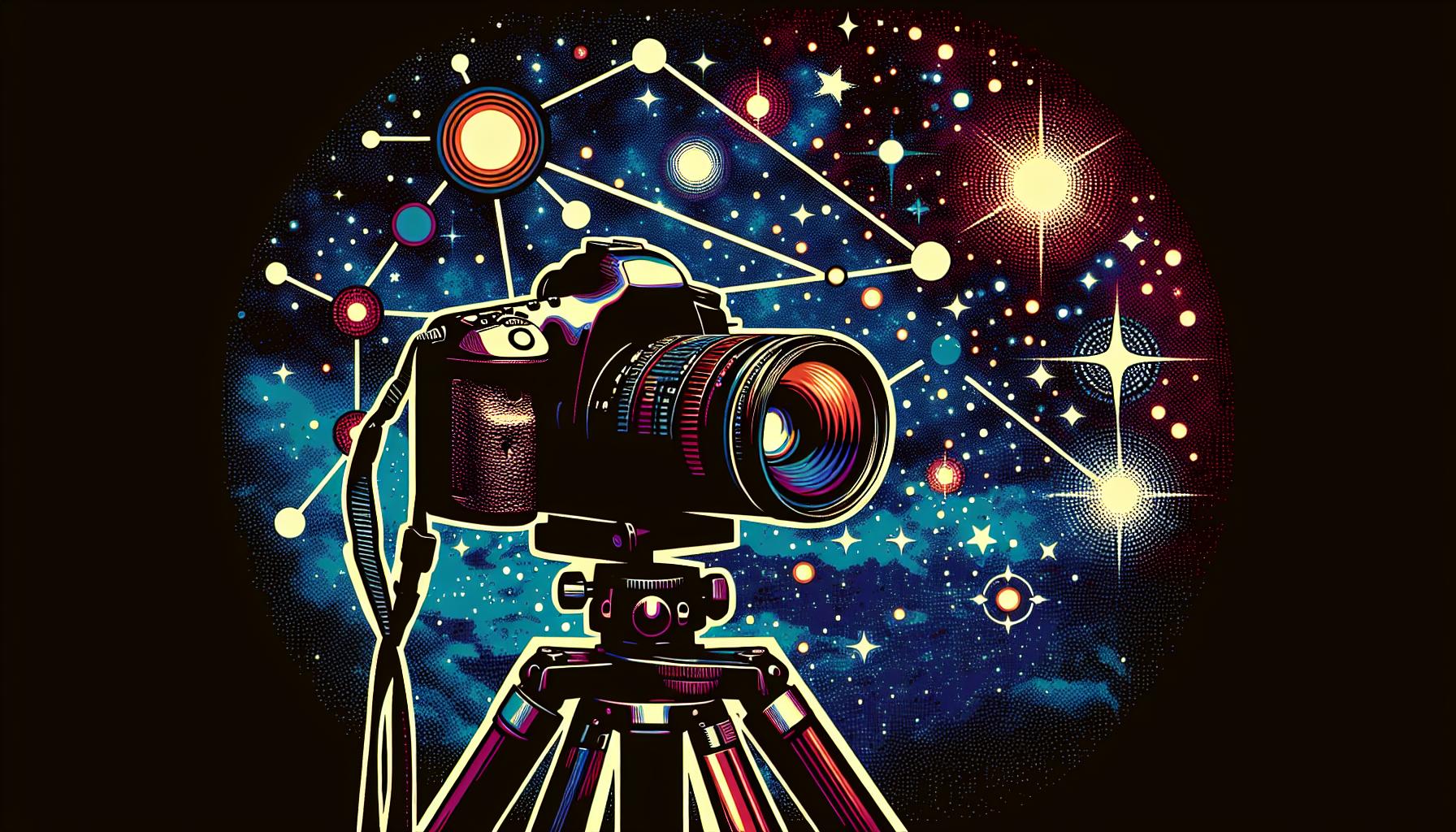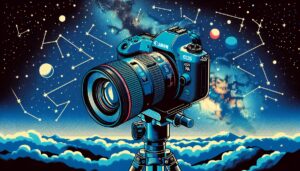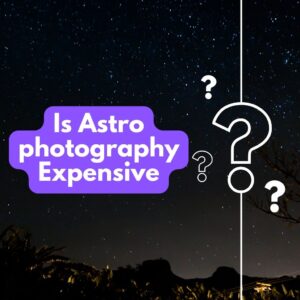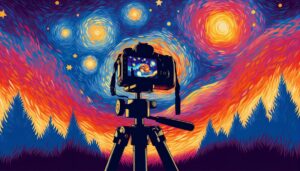This site contains affiliate links to products. I may receive a commission for purchases made through these links.
When it comes to astrophotography, the Canon 6D is a game-changer. Its full-frame sensor and high ISO capabilities make it a favorite among stargazers and photographers alike. I’ve been using this camera for years and it’s consistently delivered stunning shots of the night sky.
The Canon 6D’s low light performance is a key factor in its success in astrophotography. It’s not just about capturing stars, but also about revealing the intricate details of galaxies and nebulae. With the right settings, you’ll be amazed at what you can achieve.
But don’t just take my word for it. I’ll guide you through the ins and outs of using the Canon 6D for astrophotography, helping you unlock its full potential. Whether you’re a seasoned pro or just getting started, there’s always something new to learn in the world of astrophotography.
Why Choose the Canon 6D for Astrophotography?
My experience with the Canon 6D has been nothing short of extraordinary, particularly when it comes to astrophotography. There are several compelling reasons why one might opt for this camera for their night sky pursuits.
Full-Frame Sensor The first point worth noting about the Canon 6D is its full-frame sensor. Pictures taken with this camera are nothing short of spectacular, with their details rich and their depth unparalleled. This feature alone propels the Canon 6D to upper echelons, making it a crowd favorite.
High ISO Capabilities: For astrophotography, the ability to increase your camera’s sensitivity to light is crucial, and that’s precisely where the Canon 6D’s high ISO capabilities shine. This means less noise in your images while you’re capturing those beautiful constellations, twinkling stars, or the Milky Way.
Low Light Performance : The 6D’s performance in low light situations is outstanding. When you’re stargazing, your camera needs to perform at its best in extremely low light conditions to capture intricate details; whether it’s the crater-filled surface of the moon, galaxies far away, or nebulae in their multicolored glory.
So, whether you’re a novice, just delving into astrophotography or a seasoned stargazer, the Canon 6D is your stellar partner, offering capabilities and features that go beyond the ordinary. With Canon 6D in your kit, you’re ready for a journey that’s out of this world.
Understanding Astrophotography Settings
Now that we’ve sunk our teeth into why the Canon 6D is an excellent choice for astrophotography, it’s time to delve into crucial settings for this craft. Whether a beginner or a seasoned photographer, understanding these settings is essential.
Firstly, the full-frame sensor and high ISO capabilities we’ve talked about are part of the package. Yet there’s more to consider. Astrophotography isn’t just about the camera, it’s about knowing how to best use it under a clear, starry sky.
ISO and Exposure
The Canon 6D’s high ISO capability is a game-changer in low-light situations. It’s recommended to increase the ISO setting to allow more light into the sensor. However, a higher ISO can generate noise, so it’s a fine balance. I’ve found that an ISO setting around 1600-3200 works well.
Exposure time is key too. A longer exposure captures more light, enabling you to snap those faint distant stars. Usually, a shutter speed of 20-30 seconds hits the mark. Just be cautious of star trails. Overly long exposures will capture the sky’s movement, creating blurred lines instead of crisp stars.
Aperture
The Canon 6D performs well with a wide aperture, aiding in the hunt for weak light sources. With this camera, an aperture of f/1.2 – f/2.8 is typically a great range to capture the galactic wonders above.
White Balance and Focus
For white balance, I set it to daylight to prevent artificial light sources from affecting the image’s color. Canon’s ability to switch quickly and accurately between focus modes adds a unique layer of versatility in astrophotography.
Indeed, these are just guidelines, and variation in settings will always be part of your creative journey in chasing celestial bodies. It reminds me of the saying, “In the night sky, you’re a perpetual student” – and with the Canon 6D, every lesson is a sight to behold.
Camera Setup and Accessories for Canon 6D Astrophotography
Now that we’ve dug into the ins and outs of the manual settings on the Canon 6D, it’s time we took a look at how to set up the camera and the accessories that will enhance your astrophotography experience.
First off, let’s start with the tripod. For any long exposure photography, which is exactly what astrophotography is, a sturdy tripod is a non-negotiable. It provides stability, and trust me, there’s nothing worse than a blurry shot of the stars. I recommend the Manfrotto BeFree Advanced Carbon Fiber Travel Tripod. It’s lightweight and compact, making it perfect for nighttime excursions.
Next, you’ll need a remote shutter release. The Hähnel Giga T Pro II is an excellent option. Having a remote allows you to trigger your camera without touching it, helping to avoid any camera shake that could lead to blurry images.
A lens is arguably the most important piece of gear after the camera itself. What’s great about the Canon 6D is that it’s compatible with a large range of lenses. For astrophotography, wide-angle lenses are your friend. The Canon EF 17-40mm f/4L USM gives you a broad view of the sky and enough aperture to let in ample light.
Here’s the part many beginners skip: focusing in the dark. The easiest way? A star pointer. The Celestron Star Pointer Finderscope can be an absolute game-changer. It projects a red dot onto the sky, which you can align with a star to get a perfectly focused shot.
Lastly, don’t forget your accessories! Spare batteries, a flashlight (to navigate in the dark), and a large memory card are must-haves for a night under the stars.
So whether you’re just starting out or looking to upgrade your gear, the Canon 6D with the right setup and accessories can make the difference between a good and a great shoot.
Tips for Capturing Stunning Astrophotos with the Canon 6D
Getting started with astrophotography might seem a daunting task. Fear not, with years of my experience, here are some tried and tested tips that can dramatically enhance your astrophotography results using a Canon 6D.
Firstly, remember to shoot in RAW format. This format captures the most detail and offers greater flexibility during post-processing. The Canon 6D’s impressive ISO range allows for shooting in various lighting environments including nighttime astrophotography. While JPEG is a practical format for casual photography, when it comes to astrophotography, RAW is preferred due to its ability to capture rich information about colors and brightness that enhance your image’s quality in processing.
Alongside, learning about some basic astronomy can make a world of difference. Knowing where and when to shoot is just as important as knowing how. Various apps and websites can aid in predicting astronomical events and the position of celestial bodies. Utilizing these resources can guide you on when to set up for the perfect shot.
No matter how good your camera and lens are, without a good understanding of the exposure triangle – aperture, shutter speed, and ISO, the end result won’t be as expected. For capturing clear and sharp images of the night sky with Canon 6D, you’ll want an aperture wide open (the lowest f-number your lens will allow), long shutter speeds, and higher ISO settings. Though higher ISO settings might add noise to your image, Canon 6D handles noise pretty well up to ISO 6400.
Multiple software available in the market can offer great help. Stacking images using software like DeepSkyStacker can significantly reduce noise and improve image quality. This technique involves shooting several identical frames and combining them to highlight the stars more prominently and minimize noise.
So, charge those extra batteries, grab a cup of warm coffee, and venture out into the night with your Canon 6D. Remember, practice makes perfect. Explore, experiment, and enjoy the process as you embark on your journey of capturing the cosmos. Lastly, don’t forget to share your stunning astrophotos with us! We can’t wait to see the universe through your lens.
Post-processing Techniques to Enhance Your Canon 6D Astrophotos
Post-processing is a vital stage in astrophotography. It’s where you enhance the visibility of celestial bodies and bring out the tiny, intricate details of the night sky. I have a toolbox of recommended apps and techniques to help develop your Canon 6D astrophotos into epic images.
Lightroom and Photoshop are fine examples of comprehensive post-processing tools. They offer a host of features, from color balancing to image stacking, which can tremendously elevate your photos. Remember to always work with your RAW format photos in these apps. The RAW format’s wider dynamic range and color depth help extract the best details during processing.
Adjusting the exposure and contrast can make celestial bodies pop against the deep black of space. For instance, tweaking the highlight, shadows, and whites in your Lightroom settings brings out exciting details in the Milky Way or on the surface of a celestial body.
Noise is an inevitable part of our astrophotography adventures, particularly when working with high ISO settings. Luckily, with appropriate noise reduction methods, you can considerably minimize its appearance. Pay attention to luminance and color sliders in your software’s noise reduction tools; they can help suppress noise without eliminating essential details.
A technique that can drastically improve the clarity of your astrophotos is image stacking. This process involves layering multiple images of the same scene on top of each other to reduce noise and heighten the level of detail. My recommendation for this would be DeepSkyStacker, it’s a powerful tool tailored to suit the specific needs of astrophotographers.
Lastly, don’t forget the value of experimentation. Try using different adjustments, effects, filters and balance to find what best suits your style. Each astrophoto is unique, it demands a unique approach.
Recommended Lenses for Canon 6D Astrophotography
Now that we’ve delved into the benefits of shooting in RAW and leveraging tools like DeepSkyStacker, it’s time to talk lenses. Your choice of lens can have a substantial impact on the quality of your astrophotos. So, what are the best lenses to use with your Canon 6D for astrophotography?
Fast, wide-angle lenses are typically most effective for astrophotography. They capture a broader field of view and let in a lot of light, which is crucial when you’re shooting in darkness.
Take, for example, the Canon EF 16-35mm f/2.8L II USM. This lens allows you to capture expansive, ultra-wide images of the night sky. The large aperture (f/2.8) also ensures your camera’s sensor receives plenty of light, helping you catch more stars in less time.
Another excellent choice is the Samyang 14mm f/2.4. Although it’s a manual focus lens, it has a substantial advantage in that aspect. Manual focus allows you to precisely focus on stars and other celestial bodies. The Samyang also hits that sweet spot of performance and affordability, making it a great choice for astrophotography beginners.
Astrophotography is a blend of art and science. No lens is a one-size-fits-all solution. The lens you select will depend on your personal style, the type of celestial objects you want to photograph, and your budget. It’s worth experimenting with different lenses to find your perfect match.
On this journey of learning astrophotography, remember: you’re capturing the beauty of the universe with your Canon 6D—one frame at a time. Up next, we’ll discuss other tools and gadgets that can smooth your astro journey even further.
Common Challenges and How to Overcome Them
Navigating the realm of astrophotography with a Canon 6D can indeed be a rewarding experience, but it’s not without its fair share of challenges. The good news – it takes just a bit of determination, patience and the right knowledge to overcome these obstacles. So, let’s dig right into some of the common hurdles you might encounter, and how to best tackle them.
Tackling Noise – Noise is a common menace for all astrophotographers. High ISO settings can lead to an increase in digital noise. But fret not, it’s manageable. Shooting in RAW format, as already discussed, is a step in the right direction. Also, remember to use software like DeepSkyStacker to your advantage, as it’s designed to reduce noise and and improve image quality.
Balancing Exposure – Nailing the perfect balance of exposure for the night sky and the stars is crucial. It’s easy to overdo exposure, leading to lost star details. A good place to start is by using a 500-rule guide. Experiment with your settings. You’ll need to adjust based on your specific lens and conditions for the perfect shot.
Finding the Right Lens – With so many options available, selecting the perfect lens can be overwhelming. We’ve recommended a few earlier, like the Canon EF 16-35mm f/2.8L II USM and the Samyang 14mm f/2.4. These lenses provide a wide field of view and excellent low-light performance, making them stellar (pun intended) for astrophotography. But remember, what’s most important is that you experiment to find what works best for you and your style.
Conclusion
I’ve shared how the Canon 6D can be your ally in capturing the beauty of the night sky. With the right approach, shooting in RAW and utilizing tools like DeepSkyStacker, you’ll get stunning images that truly represent the universe’s grandeur.
Remember, managing noise and balancing exposure are challenges you can overcome with practice and patience. The right lens for your Canon 6D might be just around the corner, so don’t be afraid to experiment. The night sky is waiting for you to capture it. So grab your Canon 6D, and let’s make some astrophotography magic happen.
Don’t forget to subscribe to our newsletter where you’ll find the latest cosmic discoveries, expert stargazing tips, and exclusive subscriber deals. Embark on your cosmic journey if you haven’t already!
Frequently Asked Questions
What are some tips for astrophotography with the Canon 6D?
You should consider shooting in RAW format to preserve the most detail and use software such as DeepSkyStacker to manage noise and improve overall image quality.
What are common challenges in astrophotography with the Canon 6D?
The main challenges include dealing with noise, ensuring balanced exposure, and finding the right lens. Experimentation is crucial in finding solutions to these challenges.
Why should I shoot in RAW format when taking astrophotos with the Canon 6D?
Shooting in RAW captures more detail and provides greater flexibility in post-processing, making it the most efficient way to tackle noise and exposure challenges in astrophotography.
What does DeepSkyStacker offer?
DeepSkyStacker is software designed to reduce noise in astrophotography. It significantly improves image quality by stacking multiple images to enhance signal-to-noise ratio.
How can I find the right lens for astrophotography with the Canon 6D?
The choice of lens largely depends on the specific scenarios and subjects you want to photograph. Experiment with different lenses until you find the one that best fits your needs.




